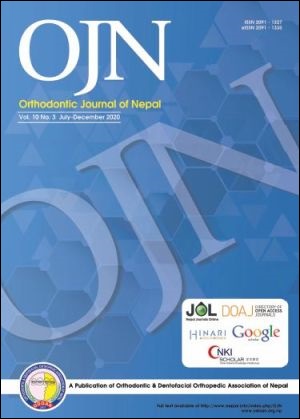Frequency of Extractions in Various Skeletal Patterns in Orthodontic Nishtar Institute of Dentistry, Multan
DOI:
https://doi.org/10.3126/ojn.v10i3.35488Keywords:
Dentistry, Extraction, Frequency, Malocclusion, Skeletal, Teeth, OrthodonticsAbstract
Introduction: When the 20th century started Orthodontics was first recognized as a science. The removal or extraction of teeth destroys the ideal esthetics and occlusion, which was the base of orthodontic treatment plans. Edward Hartley Angle and his followers were not supporters of extraction due to this reason. Extreme dental or maxillary protrusion leading to facial deformities could be corrected by dental extraction was supported by Calvin Case who was a strong opponent of the Angle., for mainly analyzing the frequency of use of orthodontic extractions after evaluating the changes in the use of extraction in past years. The frequency of extractions was examined in relation to gender and Angle’s malocclusion classification.
Materials and Method: This is a retrospective observational study. It was conducted in Orthodontics Department of Nishtar Institute of Dentistry, from 2015 to 2020. In this study records from 1032 patients who reported to orthodontic department in Nishtar institute of dentistry Multan for fixed orthodontic treatment were taken. For data registration SPSS 20 (IBM Chicago Illinois) was used. Frequency of extractions with regards to gender, skeletal pattern and types of extraction pattern was determined. In order to assess the association among variables Chi square test was applied and a P value of less than 0.05 was considered as significant.
Result: In respect of extraction group, 222 (41.3%) were males and 316 (58.7%) were female and whereas in nonextraction group, 83 (16.8%) were males and 411 (83.2%) were females. The difference was statistically significant (p<0.001). The frequency of extraction in reference to Angle’s classification was analyzed, and no significant difference was found (p=0.992). Frequency of extraction was highest in class-II division-I malocclusion, and the lowest frequency of orthodontic tooth extraction was seen in class-II division-II malocclusion.
Conclusion: It can be concluded from the results of our study that females had higher frequency of extractions as compared to males. Similarly, class II malocclusion patients had highest frequency while lowest frequency was in Class I malocclusions.
Downloads
Downloads
Published
How to Cite
Issue
Section
License
Copyright © held by Orthodontic & Dentofacial Orthopedic Association of Nepal
- Copyright on any research article is transferred in full to the Orthodontic & Dentofacial Orthopedic Association of Nepal upon publication in the journal. The copyright transfer includes the right to reproduce and distribute the article in any form of reproduction (printing, electronic media or any other form).
- Articles in the Orthodontic Journal of Nepal are Open Access articles published under the Creative Commons CC BY License (https://creativecommons.org/licenses/by/4.0/)
- This license permits use, distribution and reproduction in any medium, provided the original work is properly cited.




